Hunting is a grand tradition, valuable skill, and treasured pastime. Many people all across the world enjoy and are enthralled by their time afield in pursuit of game. Hunting is a way to reconnect with our more primordial nature and sincerely participate in the remorseless beauty of the natural order.
Aside from mere enjoyment and excitement, knowing how to hunt a variety of game is an important skill for preppers. The ability to sustain or supplement with meat the food stores for yourself and your group or family is priceless.
A discussion on hunting can and has filled volumes of books; big game and small, hunting in various climates and regions, tools of the trade and weapons of choice. Hunting encompasses many disciplines; field craft, knowledge of your quarry, knowledge of the terrain, expertise with a weapon, patience, focus and endurance.
But no matter what kind of game you are after, or what kind of hunt you are on, you’ll need to go forth prepared. Unless you are hunting house mice, hunting will always take place in areas far enough from civilization that the stakes are higher if things go wrong. Maybe it is your fault or error. Maybe it is bad luck or just an accident. It does not matter.
Having the right tools and equipment will increase your odds of success, and if you have chosen smart also give you a leg up should you fall victim to mishap or misadventure. If that happens, your hunting excursion, whether for sustenance or pleasure, will now be a proper survival situation.
In this article, we’ll be looking at equipment you should always include in your hunting kit when you head afield.
A Word on Methodology
Every hunter has his or her own idea of what a hunt should look like. Their own code or ethical bylaws if you will. Some folks take everything but the kitchen sink, their idea being that no matter what happens or what they run into in their pursuit of a kill they will have that one right tool handy.
Others are ascetics, the minimalist, people who set out with camo, weapon, perhaps a bag of jerky and little else. They see extraneous equipment as either beneath their dignity or only wasted pounds.
Other hunters are adaptive, taking more or less gear depending on the hunting area, their comfort level and the sum of their route, setting and other factors. They may go in light, heavy or somewhere in between.
You sure cannot convince some hunters of a better, smarter way, especially a hunter who is successful and has the freezer full of meat and the trophies to prove it. I am sure not going to try and do that, but I am going to make a case for hunting smart, and in this context smart means a doctrine of preparedness, just like I always preach.
My care is this: if something is going to happen, and rest assured if it can it will, then I had best be prepared for the aftermath. Some activities have higher stakes than others. Many otherwise serious mishaps can be corrected if you are in the middle of town with expert help only a call or shout away.
That same instance, or even a far lesser one, somewhere on the backside of beyond with no one around and a cell signal a laughable notion, you are your only first responder and likely your only hope.
This does not have to mean hauling around a huge contingency package of “just-in-case” items; with careful thought and selection one can achieve a holistic level of readiness where the things you have carried to help your hunt can also serve double-duty as tools to help you survive.
It is those items that will make it on to my list. You might note that some items you should expect to see on a general readiness and preparedness list will be absent, things like a first-aid kit, matches, ferro rod, and so on.
Those are things you definitely should have, certainly, but they are dedicated survival items, not gear used in pursuit of game, so I have deliberately left them off.
So, while you may think this makes the less than comprehensive, I believe my approach makes it more interesting, and a better exercise in assessing what a piece of gear, or tool, can do for you beyond what it was designed to do.
Making more from less, or adapting to overcome a challenge at hand is a tenet all preppers (and hunters!) should ascribe to. Additionally, taking a light load of gear that is backed up by skill and the know-how to use it is the height of elegance and will make your hunt far more enjoyable than if you were hauling around 45 pounds of equipment.
Considerations
What equipment falls into the category of “necessary” is somewhat dependent on the animal you are after. A folding saw is of great use in any woodland area but nearly useless in the desert or plains. Hiking poles are invaluable in broken, hilly terrain, but may not seem worth it on flat land.
Keep in mind there are very few truly universal pieces of equipment. Sometimes carrying a certain piece of gear may simply seem indulgent or a waste of space and weight. But before leaving it out, ask yourself if that item might take on an important new role in a survival situation, might be valuable enough to warrant its inclusion.
In my estimation, frankly, a great many hunters take needlessly stupid risks. Some eschew equipment because they are hunting land that they proclaim to know like the back of their hand.
Some take a devil-may-care attitude when it comes to safety and potential injury. The list goes on, but I cannot help but be aggravated by the stories I hear and the practices I see.
I am not a big-time hunter. I have hunted plenty, but do not live for it as some others do. What hunting I have done I took to with the same methodical approach to ensuring success and keeping both life and limb that has served me so well in life and in my career.
That approach has no doubt influenced my equipment choices. You might disagree, but I trust that if you are honest you will see both the logic and value in those selections, even if you yourself may prefer a different way.
15 Must-Have Hunting Tools
All of the tools, goodies and gadgets are presented in no particular order. I have carried and still carry all of them afield whenever I am hunting, no matter if I am after squirrel, boar or deer.
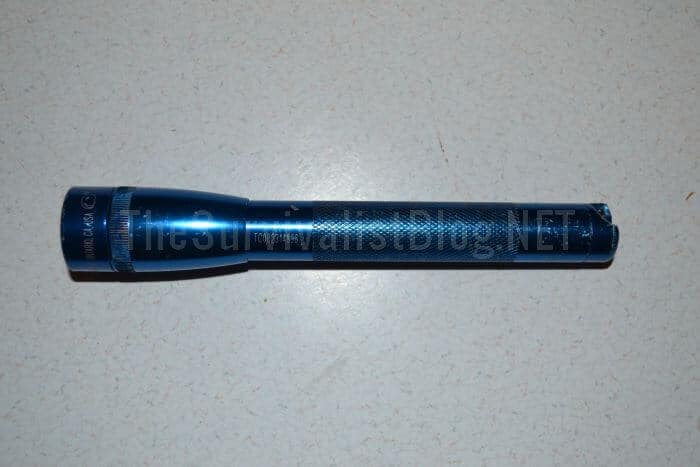
#1. Flashlight
A bright, durable flashlight is a great piece of gear to have anytime you are heading out into the wilderness. Its utility for finding your way before dawn, after dusk or in the dead of night is obvious, but a flashlight equipped with a blue filter can help you spot and track blood far easier than you could otherwise, and red or green filters help you preserve your night vision and are not nearly as noticeable as white light.
Some folks, even hunters, forget just how dark it can get out of doors, especially on cloudy or moonless nights far from civilization and this goes double if you are under a canopy of trees.
A few minutes time in the woods can send you hurtling from dusk into ink-black night. It is a sobering, scary thing to get turned around in the woods at night. A flashlight is your cure for that problem.
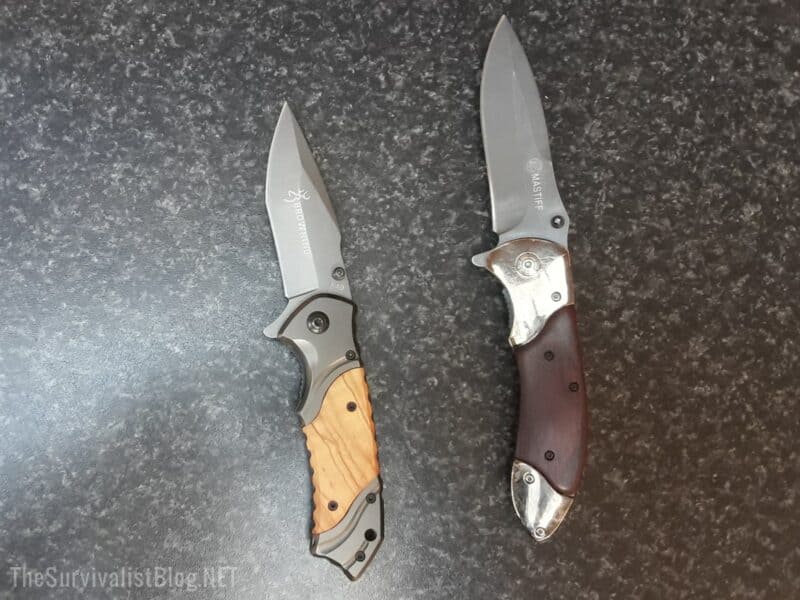
#2. Knife
A good knife should be your constant companion afield, and this is most true when hunting. A sturdy knife is your mainstay when it comes time to process your kill in the field, if required, but also for chores at the blind, stand or camp. No matter what kind of game you are after and how far or how long you plan on staying out, if you don’t have a knife you are wrong. It’s that simple.
Should you need it in an emergency context, your knife will be one of your chief tools for shelter creation and the processing of tinder for a fire. A knife is well suited for carving precise shapes in all kinds of materials, often necessary for the creation of a sturdy shelter from found materials.
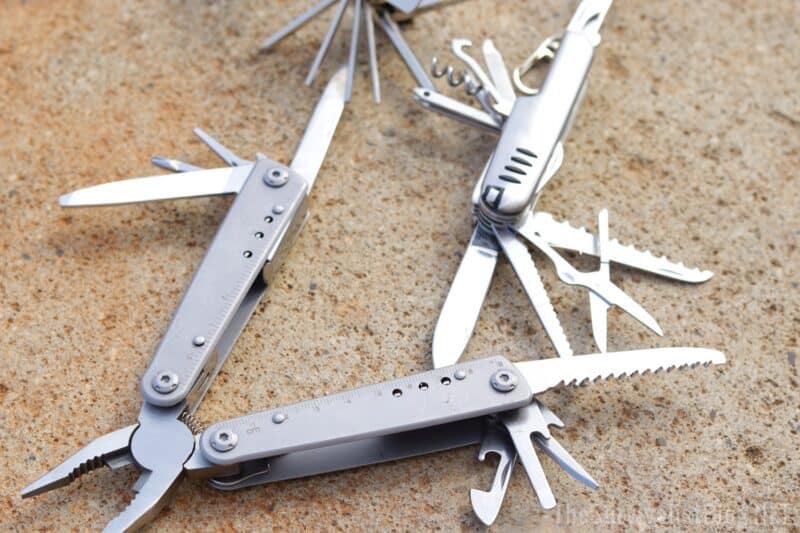
#3. Multi-Tool
A good, pliers-type multi-tool is invaluable when hunting.
From tuning up errant screws and bolts on weapons, stands and so forth to plucking out splinters, thorns and other unpleasant pests, a multi-tool is your go-to for tasks that your knife cannot handle, and will as a rule include a blade of its own that you can use as a secondary or backup.
Multi-tools are likewise helpful in emergencies for all of the same reasons. Having the right fastener or tool at hand can prevent equipment failure that may otherwise spoil a hunt or see you stranded.

#4. Cordage
Paracord, accessory cord, or guyout cord, whatever you prefer and think is adequate to the task of hoisting gear or game is what you should carry.
A hank or small roll of cord takes up almost no room and weight in your pack or pockets and will help you secure or hang your hard-won game for processing or transport.
Additionally, it works great for field improvising anything from a rifle rest to a camp seat. Cordage can also be parceled out for use as discreet trail markers, wind indicators and dozens of other tasks afield.
If you are unfortunate enough to put your cordage to use keeping your ass alive, you’ll be doubly glad you brought it, as cordage can turn shelter creation or impromptu fashioning of a sling or splint into a comparatively simple affair instead of a frustrating, agonizing trial.
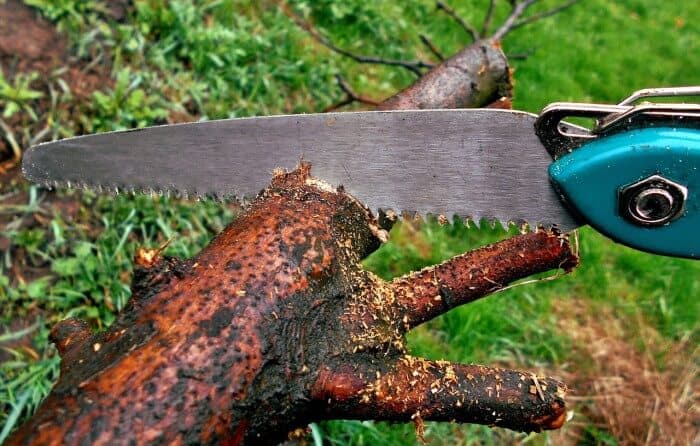
#5. Folding Saw
Unless you are hunting in an area with absolutely no trees, a folding saw is a boon when you need to clear limbs for a stand, open up a shooting lane or erect a frame or sledge after the hunt is over. A folding saw is typically safer and faster to use than an axe or hatchet, and weighs far less than either in most iterations. Easily stored and easy to use.
The saw’s other obvious use is in the collection of firewood and the building of shelters. A saw, kept sharp, makes light work of even thick, heavy limbs, and often needs less muscle to accomplish the task compared to a chopping tool.
Axes and hatchets are the traditional “woodsman” tool for all contingencies, but in my experience the saw does 90% of what you’d carry a chopper for and does so with less weight, bulk and sweat. That’s a win.

#6. Binoculars / Monocular
Humans rely on sight as our primary sense, especially when hunting. We are optically predisposed, you might say. A whole big bunch of animals would rather rely on their noses, than their eyes, but don’t tell camo companies that. As such, it makes sense to increase our range of vision as far as we can, increase our resolution as much as we can, and pierce gloom as well as we can.
Enter the handheld optic. Be it a set of powerful binos or a compact monocular, either will fit the bill for general purpose scouting and peeping for sign or trace of game.
You might think you could simply use your rifle scope for this if you have one equipped, but this is not the safest or most efficient use of that sight. Not to mention, even a flyweight rifle and scope held up for extended periods gets very heavy; ever tried isometrics?
For survival, one of these far-seers will allow you to assess your path of egress for suitability, and perhaps spot help or an escape route before you commit to burning calories, daylight and time tromping all over creation when lost.
A decent vantage point and a set of binoculars will often reveal a way out or point of interest invisible to the eye alone.

#7. Hiking Pole, collapsible
Quick disclosure: If you visit a link in this article and then you buy something, I may earn a commission. As an Amazon Associate I earn from qualifying purchases. You can read my full disclosure here.
No matter where I am going, and I mean no matter where, I always take at least one, sometimes two collapsible, length adjustable hiking poles with me.
Aside from their obvious use helping to reduce fatigue and prevent a slip, trip, fall or tumble when negotiating anything from a steep hillside to a rocky river crossing, you can probe suspect areas for snakes and other undesirable critters. These can function as true shooting and glassing multi-tools.
Choosing a pole that has a threaded opening in the top of the handle, I can affix a yoke to help me steady a long gun, or with an adapted I can screw a monocular or spotting scope right into it for greater stability.
Alternately, I can cross the pair of them and lash them together to make a very excellent bipod when sitting or kneeling.
When things have gone sideways and I am contemplating my life choices in the wake of this latest disaster, this can form excellent supports for a shelter, either as beams for a roof or stakes for a tent arrangement. Indispensable and very light weight should you spring for the better ones.
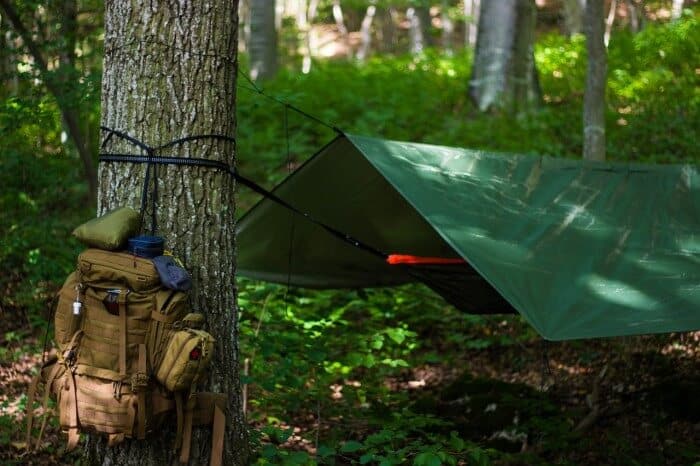
#8. Tarp
When the time comes to pack out my kill or the meat and parts taken from it, I do not necessarily want to get any more blood and gore on my backpack than necessary.
It isn’t anything to do with squeamishness or foppery, it is simply preventative care; washing and scrubbing to get any kind of substantial blood out of nylon and other synthetic fabrics takes a heavy toll on their lifespans. I’d rather my kit last, thank you very much.
A clean, grommeted large synthetic tarp makes the perfect piece of jumbo butchers’ wrap for the job, and carried in their original packaging or, even better, vacuum packed down really tiny and quiet, takes up little room, adds little weight and pays for itself with one success.
A tarp, as I and others have written about in extreme detail, is also another do-it-all survival implement, able to form a good waterproof shelter, ground cover or even water collection device.
A good tarp will block wind and moisture, and together with your cordage above and either found materials or your hiking poles can be fashioned into a very serviceable tent.
Don’t set out without it.
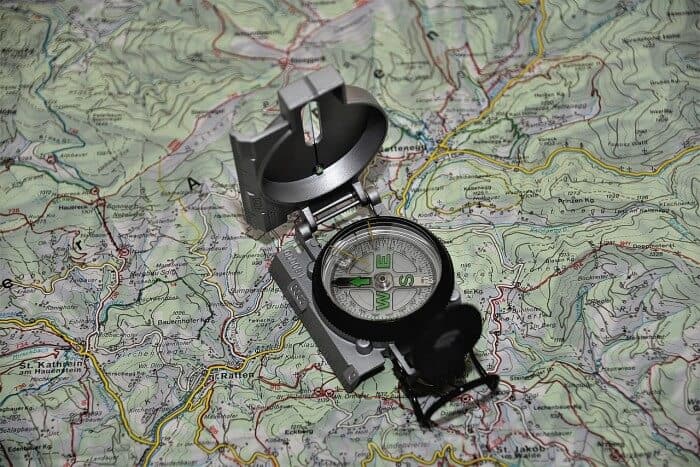
#9. Compass
Some of us go farther out than others. Even in a place we have travelled many times, a moment of disorientation or inclement conditions creating low visibility can get us turned about.
A compass together with even a sketched map or landmark directions will ensure you get to and from your hide or stand, and also back out again.
Another great use for your compass is taking a general bearing on the direction an animal is heading when stalking or when running down wounded prey.
It is so, so simple to get turned around when flush with excitement, and a quick read on your compass will give you a general line to follow out and back to the area you shot from.
A compass’s survival value is obvious, should you become lost. Even sparse general knowledge of the area you are hunting in and major features in it can allow you to, with your compass, start out in the direction that will get you closer to safety and rescue if not out of danger completely.
You can use a field or trekking compass for more detailed work, or a small, button compass clipped to your watch or on a bracelet for quick, coarse direction finding. My love for the Suunto Clipper is well known.

#10. Gloves
I don’t care who you are and how tough you think you are; there are a hundred ways to chew your hands up in any environment you can think of.
From prickly plants to poisonous sap, rusty barbed wire and broken glass, sharp knives to sharp antlers and teeth, an injury to your hand can quickly turn into a show stopper. Game over.
Protect your hands, be they leathery paws or baby-soft banker’s hands, with a pair of quality gloves suitable for use in your environment and the weapon you are using.
Some folks prefer one of the waist mounted kangaroo style hand warmers in chilly environments, and those work great, but they do nothing to keep your mitts safe when you are working.
You want gloves in a survival situation for the exact same reason you want them when enjoying the thrill of the hunt: you’ll be relying on them to get vital work done, and if your hands quite functioning you’ll be in a no-win situation for sure. Well, maybe not for sure, but you sure ratcheted up the difficulty a few clicks.
#11. Rain Cover / Poncho
Even with an up-to-the-minute forecast, sometimes Mother Nature will surprise you, and I suppose the weathermen. Even a light misting can soak you give time, to say nothing of a downpour.
If you are stalking or shooting form a hide or stand, this will do much to sap your morale as well as your body heat. A compact, quickly donned rain cover can help you beat the worst of it, and will take up very little room in your kit.
Like gloves, this has obvious and universal utility whether or not your expedition is going according to plan. Exposure is a perennial and persistent killer, and once you get wet you might have a hard time staving off hypothermia, especially if it is dark, and doubly so if it is breezy or windy. Like the tarp, this can double as a ground cover if you need to wait in place on very muddy or wet ground.
Choose a model that is light and sturdy, and preferably one treated or constructed in such a way that it keeps the crinkle and crackle of taking it off or putting it on to a bare minimum. Announcing your presence to every critter in the county is not a winning move.
#12. High-Vis Mesh Vest
Like the kind you see construction workers and event staff wearing. I am not convinced of the visual acuity of most animals, at least compared to humans.
Remember that most of our fathers and grandfathers hunted in plaid or field drab, and many of them bagged plenty of game. Scent and motion is the great betrayer of presence with most species. Even so, I know most hunters are all about some camo though, and it some spurn the safety value of high-vis marking on their attire despite the obvious safety value.
It seems like every year we have more stories of idiot hunters shooting at movement without verifying their target and, horror, striking a fellow, or someone simply screwing up and shooting at what they swore was their quarry only to hit another person instead.
Many of these incidents can be mitigated by simply donning a conspicuously visible marking element, of which blaze orange is traditional and so highly visible it can be seen from space almost.
Instead of wearing clothing with that color integrated, I choose to carry and don as appropriate depending on circumstance and need a flyweight mesh vest in an appropriate color.
This gives me additional flexibility too; I can double it into a band and wear it around my headgear or an arm, drape it over something nearby or easily and painlessly don it over my clothing as usual. If I am lost, stranded or incapacitated, anything that will make me and my location more visible to rescuers is a boon.
#13. Mini-Chemlights
I tend to ramble when out in nature, even when hunting. You too may have to get quite off the beaten track in pursuit of a shot animal. In the excitement of the moment and the confusion of darkness closing in, it is all too easy to become disoriented running down the path of your quarry. This is to be avoided.
We could take a lesson from Hansel and Gretel, and leave a trail of breadcrumbs behind, but there are many denizens of the forest who love bread as much as we do. A better play is to put a 21st century update on that idea and use a chemlight, or glow stick.
My love of chemlights for utility and survival purposes is well known, and that extends to my hunting forays. The tiny ones used for fishing lures are ideal, or you can increase visibility and brightness by upping the size to the small 1 ½” kind from Cyalume.
When the time comes to make your way to, from or back to camp or vehicle from anywhere, simply snap, shake momentarily and either drop on the ground or affix to local terrain to furnish yourself a can’t-miss-it marker. Daisy chaining these together gives you a virtual highway in times of low or no light.
Should I need to survive a time outdoors, these same lights can be attached to your person to increase your own visibility at night, and will also provide a totally reliable and completely safe light source for close work. The tiny ones are quite light, and a bundle of 20 is no inconvenience at all to carry.

#14. Toilet Paper
No matter where I am going or how long I plan to stay out, I always pack some TP with me. Off a roll or in a package, I keep it in a heavy-duty Zip-Loc brand freezer bag so its integrity is assured.
This is one of those things that may not come to you at first thought, but when you need to go, having it will make a big difference in your overall comfort as well as your cleanliness.
If you are moving out of hunting territory into survival territory, TP serves that self-same purpose while also making a decent source of tinder for emergency fire starting. It burns up quickly and none too fiercely, but it takes a flame easily.
You aren’t more of a survivor man or woman for eschewing something that will keep your backside and hand clean.
Sure, you can make use of natural materials, but why go through the hassle, discomfort and risk a possible mishap of poo under your fingernails for no reason for want of just a little TP?
#15. Pack / Chest Rig
You’ll need something to carry all of these goodies in along with other assorted hunting and outdoor accoutrement, and that means you’ll need a good pack.
Perhaps as important as good pack, and especially well suited to hunting, is a quality minimalist chest rig or pouch, one that will let you keep commonly used items close at hand and easily accessible with minimal noise and movement. This has the added benefit of allowing you to use a smaller pack, as some of your cargo is now on your front.
When I say chest rig, I am not talking about a huge military or police style plate carrier or fighting rig suitable for holding rifle mags aplenty or scads of shotgun shells. I am talking about a small platform, large enough for a multipurpose admin pouch, and perhaps a smaller pouch for larger or bulkier items.
For those who have never tried this approach, give it a whirl and I think you’ll see the merit in it. The overall boost in efficiency is significant, and reducing the size of my pack is always a plus from a mobility perspective, especially when moving through brush or other rough terrain.
As you might be thinking already, both of these items work far better and more comfortably than stuffing your pockets with all kinds of items, and even though ascetic minimalist hunting is preferred by some, recall as I said above that any time you are heading into deep country far from civilization the stakes are higher. Death waits for the unlucky, unwary or arrogant to suffer the slightest lapse in concentration.
Takeaway
All of the above gear are things I take afield habitually when hunting, and lest you think it is a bunch of junk and too much to carry, it all weighs in at 10 lbs. total, and fits in my pack and chest panel with ease and room to spare.
Now add in some food and water, my first-aid kit, and an extra outer layer of clothing in case of weather or emergency, and my support kit is right at 15 lbs. Easy peasy, and I can march all over creation toting it.
Having the right tools will greatly increase both your success rate and enjoyment of the hunt, while also giving you a hedge against disaster should you wind up staying out in the wild blue yonder against your wishes.
Do not let pride, laziness or some misaligned sense of ethics prevent you from taking the things you need to get an advantage over nature and beast.

Charles Yor is an advocate of low-profile preparation, readiness as a virtue and avoiding trouble before it starts. He has enjoyed a long career in personal security implementation throughout the lower 48 of the United States.

Most ,if not all that was suggested is needed and could be or should be used. that being said, I’ve never hunted more than a quarter mile from my truck. Heavy winter clothing ( I usually hunted late fall to mid winter ) and hand warmers and foot warmers are really nice. Also I use a plastic sled for hauling the deer back to the truck and then I’ve made a ramp with a winch ( boat winch ) to get the critter into te pu as I hunt alone ( which I shouldn’t do, but then again I’m a bull headed old fart according to my wife ). there are many other things that you can or could do with or use to be successful in your, just play it by ear or go with someone that has been around longer to help you alone.